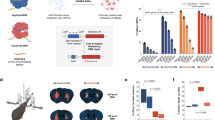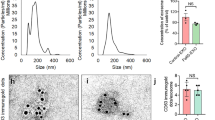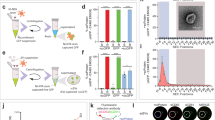Abstract
To realize the therapeutic potential of RNA drugs, efficient, tissue-specific and nonimmunogenic delivery technologies must be developed. Here we show that exosomes—endogenous nano-vesicles that transport RNAs and proteins1,2—can deliver short interfering (si)RNA to the brain in mice. To reduce immunogenicity, we used self-derived dendritic cells for exosome production. Targeting was achieved by engineering the dendritic cells to express Lamp2b, an exosomal membrane protein, fused to the neuron-specific RVG peptide3. Purified exosomes were loaded with exogenous siRNA by electroporation. Intravenously injected RVG-targeted exosomes delivered GAPDH siRNA specifically to neurons, microglia, oligodendrocytes in the brain, resulting in a specific gene knockdown. Pre-exposure to RVG exosomes did not attenuate knockdown, and non-specific uptake in other tissues was not observed. The therapeutic potential of exosome-mediated siRNA delivery was demonstrated by the strong mRNA (60%) and protein (62%) knockdown of BACE1, a therapeutic target in Alzheimer's disease, in wild-type mice.
This is a preview of subscription content, access via your institution
Access options
Subscription info for Japanese customers
We have a dedicated website for our Japanese customers. Please go to natureasia.com to subscribe to this journal.
Buy this article
- Purchase on SpringerLink
- Instant access to full article PDF
Prices may be subject to local taxes which are calculated during checkout



Similar content being viewed by others
References
Simpson, R.J., Jensen, S.S. & Lim, J.W. Proteomic profiling of exosomes: current perspectives. Proteomics 8, 4083–4099 (2008).
Schorey, J.S. & Bhatnagar, S. Exosome function: from tumor immunology to pathogen biology. Traffic 9, 871–881 (2008).
Kumar, P. et al. Transvascular delivery of small interfering RNA to the central nervous system. Nature 448, 39–43 (2007).
Seow, Y. & Wood, M.J. Biological gene delivery vehicles: beyond viral vectors. Mol. Ther. 17, 767–777 (2009).
Valadi, H. et al. Exosome-mediated transfer of mRNAs and microRNAs is a novel mechanism of genetic exchange between cells. Nat. Cell Biol. 9, 654–659 (2007).
Skog, J. et al. Glioblastoma microvesicles transport RNA and proteins that promote tumour growth and provide diagnostic biomarkers. Nat. Cell Biol. 10, 1470–1476 (2008).
Quah, B.J. & O'Neill, H.C. The immunogenicity of dendritic cell-derived exosomes. Blood Cells Mol. Dis. 35, 94–110 (2005).
Inaba, K. et al. Generation of large numbers of dendritic cells from mouse bone marrow cultures supplemented with granulocyte/macrophage colony-stimulating factor. J. Exp. Med. 176, 1693–1702 (1992).
Théry, C., Amigorena, S., Raposo, G. & Clayton, A. Isolation and characterization of exosomes from cell culture supernatants and biological fluids. in Current Protocols Cell Biology, chapter 3, 3.22 (John Wiley, 2006).
Simhadri, V.R. et al. Dendritic cells release HLA-B-associated transcript-3 positive exosomes to regulate natural killer function. PLoS ONE 3, e3377 (2008).
Flint, P.W., Li, Z.B., Lehar, M., Saito, K. & Pai, S.I. Laryngeal muscle surface receptors identified using random phage library. Laryngoscope 115, 1930–1937 (2005).
Larson, S.D., Jackson, L.N., Chen, L.A., Rychahou, P.G. & Evers, B.M. Effectiveness of siRNA uptake in target tissues by various delivery methods. Surgery 142, 262–269 (2007).
Yin, H. et al. A fusion peptide directs enhanced systemic dystrophin exon skipping and functional restoration in dystrophin-deficient mdx mice. Hum. Mol. Genet. 18, 4405–4414 (2009).
Nunes, F.A., Furth, E.E., Wilson, J.M. & Raper, S.E. Gene transfer into the liver of nonhuman primates with E1-deleted recombinant adenoviral vectors: safety of readministration. Hum. Gene Ther. 10, 2515–2526 (1999).
Gonzalez, S.C. et al. Readministration of adenoviral gene delivery to dopamine neurons. Neuroreport 18, 1609–1614 (2007).
Laird, F.M. et al. BACE1, a major determinant of selective vulnerability of the brain to amyloid-beta amyloidogenesis, is essential for cognitive, emotional, and synaptic functions. J. Neurosci. 25, 11693–11709 (2005).
Singer, O. et al. Targeting BACE1 with siRNAs ameliorates Alzheimer disease neuropathology in a transgenic model. Nat. Neurosci. 8, 1343–1349 (2005).
Nishitomi, K. et al. BACE1 inhibition reduces endogenous Abeta and alters APP processing in wild-type mice. J. Neurochem. 99, 1555–1563 (2006).
Aguzzi, A. et al. Protein aggregation diseases: pathogenicity and therapeutic perspectives. Nat. Rev. Drug Discov. 9, 237–248 (2010).
Kao, S.C., Krichevsky, A.M., Kosik, K.S. & Tsai, L.H. BACE1 suppression by RNA interference in primary cortical neurons. J. Biol. Chem. 279, 1942–1949 (2004).
Mosmann, T. Rapid colorimetric assay for cellular growth and survival: application to proliferation and cytotoxicity assays. J. Immunol. Methods 65, 55–63 (1983).
Acknowledgements
The authors would like to thank I. Sargent and his group, especially A. Brooks, for their assistance with the LM10-HS system, J. Morris for his help with the electron microscopy, D. Morrissey and his laboratory at Novartis, Basel, for supplying the RVG-9R peptide and the Wood laboratory members for critical reading of the manuscript. L.A.-E., C.B. and H.Y. are funded by the Muscular Dystrophy Ireland and the Muscular Dystrophy Campaign (UK). Y.S. is funded by the Agency for Science, Technology and Research (Singapore).
Author information
Authors and Affiliations
Contributions
L.A.-E., Y.S. and M.J.A.W. designed the experiments. L.A.-E. and Y.S. performed the experiments and analyzed the data except for intravenous injection, CFSE proliferation assay. H.Y. performed intravenous injections. C.B. assisted with dissection and harvesting of tissue. S.L. performed the CFSE proliferation assay. L.A.-E., Y.S. and M.J.A.W. wrote the manuscript.
Corresponding author
Ethics declarations
Competing interests
The authors have filed a patent application related to the work in this paper.
Supplementary information
Supplementary Text and Figures
Supplementary Tables 1,2 and Supplementary Figs. 1–9 (PDF 1956 kb)
Rights and permissions
About this article
Cite this article
Alvarez-Erviti, L., Seow, Y., Yin, H. et al. Delivery of siRNA to the mouse brain by systemic injection of targeted exosomes. Nat Biotechnol 29, 341–345 (2011). https://doi.org/10.1038/nbt.1807
Received:
Accepted:
Published:
Issue Date:
DOI: https://doi.org/10.1038/nbt.1807
This article is cited by
-
Targeting delivery of miR-146a via IMTP modified milk exosomes exerted cardioprotective effects by inhibiting NF-κB signaling pathway after myocardial ischemia-reperfusion injury
Journal of Nanobiotechnology (2024)
-
EphA2-specific microvesicles derived from tumor cells facilitate the targeted delivery of chemotherapeutic drugs for osteosarcoma therapy
Journal of Nanobiotechnology (2024)
-
Chondrocyte-targeted exosome-mediated delivery of Nrf2 alleviates cartilaginous endplate degeneration by modulating mitochondrial fission
Journal of Nanobiotechnology (2024)
-
Mutual regulation of PD-L1 immunosuppression between tumor-associated macrophages and tumor cells: a critical role for exosomes
Cell Communication and Signaling (2024)
-
Hotspots and trends of microglia in Alzheimer's disease: a bibliometric analysis during 2000–2022
European Journal of Medical Research (2024)



